IRQL_NOT_DISPATCH_LEVEL in Windows 10 is a Blue Screen of Death error that often occurs because of hardware or software problems. When this BSOD appears the device restarts time and again with a bugcheck value 0x00000008. Similar to other Blue screen issues, this is serious trouble but some potential workarounds successfully fix it.
Frequent reboot of computer because of IRQL NOT DISPATCH LEVEL along with BSOD creates big annoyance. Fortunately, Using automatic restart disable, Troubleshooter, Safe mode, Windows Defender scan, 3rd party antivirus removal, Driver update you may fix this issue.
Table of Contents
Solutions to IRQL_NOT_DISPATCH_LEVEL in Windows 10
Here is how to fix IRQL_NOT_DISPATCH_LEVEL BSOD Error in Windows 10 –
Disable Automatic Restart
Automatic Restart setting is rated as number one causing result for flashing IRQL NOT DISPATCH LEVEL BSOD error in Windows 10. This is a basic resolution and will not probably resolve the issue however, you would definitely have sufficient scope to fix the error. You may proceed with the following steps given below –
Step-1: Tap Win+S at one go to provoke Taskbar Search.
Step-2: Write control panel in the text field and once the result shows up, hit Enter.
Step-3: Make the view of control panel either into a small or large icon, locate System and do a click on it.
Step-4: When the new windows appear on screen, select Advanced system settings from the left pane.
Step-5: Once a new popup flash with System Properties, go to the Advanced tab.
Step-6: Move down and select Settings located under the Startup and Recovery section.
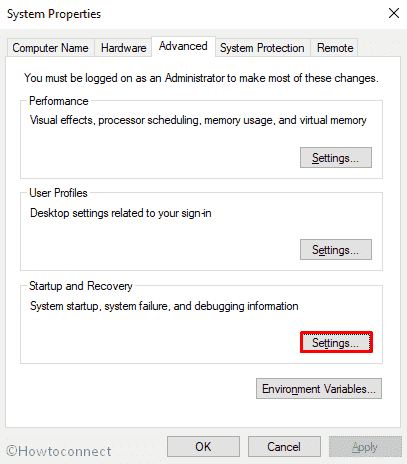
Step-7: After the new popup appears on display, move down to System failure and uncheck the box of Automatically restart option.
Step-8: Hit the OK button from bottom to proceed ahead.
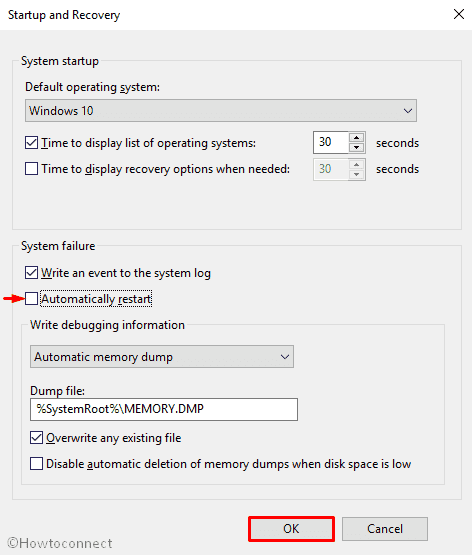
Perform Windows 10 blue screen Troubleshooter
Microsoft with each update of Windows 10 releases something big and extraordinary. As a continuation of this, they have introduced Blue Screen Troubleshooter in the Settings app. The reason was pretty clear as BSOD error are found to be ruled out in the operating system. If you are using any version greater than Fall Creators update, can access this tool to eliminate error IRQL_NOT_DISPATCH_LEVEL. Follow the below procedures to use the fix –
- Right-click on the Start button and select Settings from the visible list.
- When the page is loaded fully, hover the cursor to Update & Security section and do a click on it.
- On the subsequent page, select Troubleshoot from the left pane and then switch to the corresponding right.
- Select Blue Screen option from there, do click on it and once expanded, select Run the troubleshooter.

Upon executing the tool properly, the Operating System will fix the issues automatically and you may resolve IRQL_NOT_DISPATCH_LEVEL error pretty easily.
Boot the operating system to Safe Mode
Lots of notorious bugs were following Windows soon after Microsoft developed it. At that point, something was truly necessary that can effectively block those problems. However, Safe Mode is one of the common remedy considered for most of the BSOD error including IRQL_NOT_DISPATCH_LEVEL BSOD in Windows 10. This is how to Boot the Windows in Safe Mode –
- Press the Win + I hotkeys from the keyboard and invoke Settings app on screen.
- Once opened, move on to Update & Security section and hit a click on it.
- On the next page, select Recovery from the left pane and move along to right side.
- Jump to Advanced startup section and click the button Restart now.
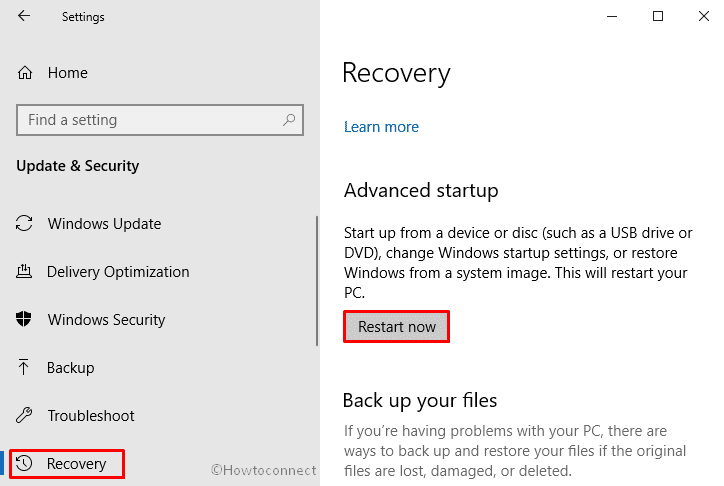
- As your Windows restarts, it will ask you to choose the next step. Choose Troubleshoot from Startup Screen.
- In the Troubleshoot menu click Advanced Options and then on Startup Settings.
- Now you will be informed that the computer can be restarted with the use of additional settings one of which is Enable Safe Mode. Press Restart.
- Subsequent to this, choose Enable Safe Mode by pressing F4.
Once deployed, the Operating System will be launched with default apps and services only. For that reason, there is a little possibility of recurrence the error again. Unfortunately, if the issue shows up again, it is quite sure that any third party application or Hardware issue is responsible for the vulnerability.
See also – How to Come Out of Safe Mode in Windows 10
Eradicate the faulty Windows update files
Microsoft releases Windows updates after a certain period comprising updated features and bug fixes. Tech Giant urges its users to download them using the Settings application. In fact, they do not indulge into troubles in the midway but if the installation process terminates abnormally, you will have IRQL_NOT_DISPATCH_LEVEL BSOD error in the Computer. All these problematic files need immediate removal in this respect. follow these below steps to do so-
- Open Windows Settings app in your device and when appears, click on Update & Security.
- This will by default open Windows Update page.
- Move to the adjacent right and Select View update history link.
- On the succeeding page click on Uninstall updates in order to remove the faulty files.
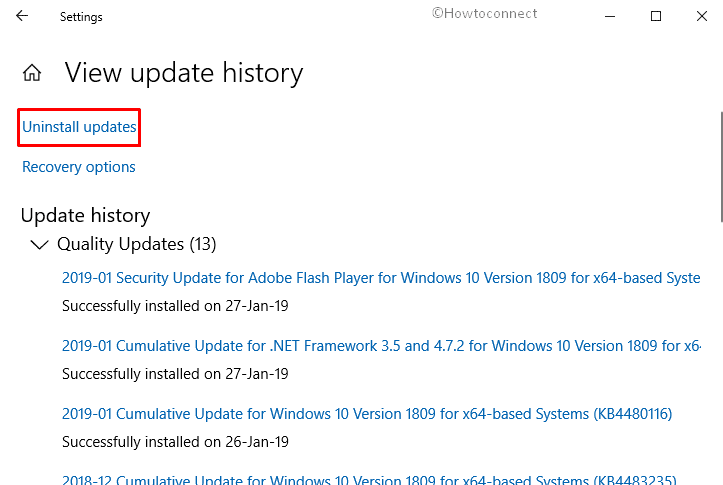
Reconnect the External Hardware Devices
Often IRQL_NOT_DISPATCH_LEVEL in Windows 10 error comes in after connecting an additional hard drive with the device. In that case, you have to remove the accessory and reconnect it again following correct procedures. The guidelines are as follows –
- Detach all the plugged accessories from the device and Restart your PC.
- When the operating system boots successfully, attach the accessories again with your PC successively and check which one is causing IRQL NOT DISPATCH LEVEL.
- Thereafter, Download the updated drivers for that specific hardware from the manufacturer website as well as Install.
Update corrupted Drivers with Device Manager
An outdated or incompatible device driver is the major reason for which IRQL NOT DISPATCH LEVEL BSOD in Windows 10 error shows up in Users device. Sometimes, people notice this same issue just after installing a new Hard Drive and by using a dreadful USB stick as well. Installing these drivers using the DVD from the delivery package or downloading from unauthorized websites found to be guilty. Therefore, simply you need to update the drivers going through Device Manager. This is how you can move on –
- Do a click on Windows button and type device manager on your keyboard.
- When the result is visible, hit Enter button to proceed.
- Once it loaded fully, locate the devices having exclamation mark beside them and expand the same by double-clicking.
- Right-click on the driver that has a yellow indication and select Update driver option to initiate the process.
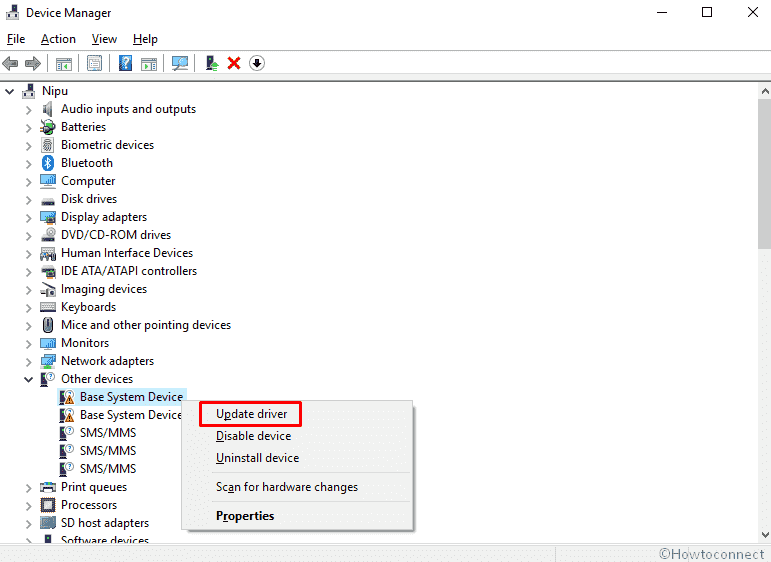
- Now the system will preview two options, Choose Search automatically for updated driver software.
- When you are done, Restart the Windows to make the changes effective.
Uninstall the Windows Operating System Program related to IRQL_NOT_DISPATCH_LEVEL file
If you have two or more similar programs in the same device, they can conflict with each other in worst cases resulting in erasing important files. In the process, IRQL_NOT_DISPATCH_LEVEL BSOD error in Windows 10 error occurs. In that scenario, you can uninstall similar programs if they are not so important. If necessary, go for reinstalling them again later on. Here is the process to proceed on –
Step#-1: Make a combined press of Windows + I keys all together to open the Windows Settings app.
Step#-2: When it comes into the sight, hove the cursor to Apps category eventually make a click on it.
Step#-3: Moving on to the next page, select Apps & features from the left pane and move alongside right.
Step#-4: Locate the program causing issues with IRQL_NOT_DISPATCH_LEVEL file. Once found, make a click on it and select the Uninstall option from the extended pane.
Step#-5: When a small pop-up turns up, again click on Uninstall to confirm the process.
Step#-6: After complete Uninstallation, visit the official manufacturer website to Download and reinstall them again in PC.
Scan your full system in Windows Security
In this tech-based world, Virus comes at the top if we talk about the threats. People can be stuck anytime anywhere while browsing or clicking a suspicious link in the Spam mail. when they get the entrance, remove system components potentially those are indeed very necessary for the operating system. Therefore, IRQL_NOT_DISPATCH_LEVEL BSOD error in Windows 10 error is more likely to happen. Performing a Full Scan can save you in this regard. You can accomplish the task using “Windows Security”, a default program of Windows 10. Following guidelines will help you to do so –
- Click on the Action Center icon from the Taskbar and select All Settings.
- Once the app opens up, click Update & Security and on the following page, select Windows Security from the left column.
- Move to the adjacent right and choose Virus & threat protection category.
- On the following window, select Scan options link from the right side.
- Select the radio button of Full scan and then click Scan now option to initiate the process.
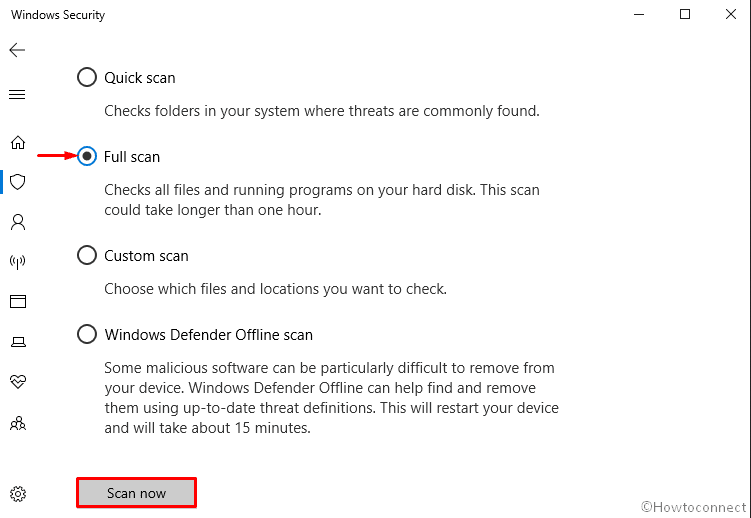
Also, Read – How to Use Windows Security App to Stay Safe in Windows 10
Remove third Party Antivirus Program
Third party antivirus programs are not trusted every time and quite often they create issues. IRQL_NOT_DISPATCH_LEVEL BSOD error in Windows 10 error is also a result of using them sometimes. With the Internet spread all over, Malware gets easy entrance to the system and cause destruction. Microsoft introduced the best Utility ever for Malware issue and Windows Security is a complete solution. Therefore, you can easily go for uninstalling them to escape hassles. For example, we are showing the standard way to uninstall Avast Anti-virus from our computer for your good understanding –
- Press Win+R at a time to open Run Dialog.
- Once it cuts in the display, type appwiz.cpl in the empty text field and select OK button.
- In the Programs and Features window, locate Avast Free Antivirus from the appearing list and do a click on it.
- Hit the Uninstall button at the top.

- Avast setup menu will now come into the sight. Select the Uninstall tab at the bottom and then click on Next.
- Once UAC prompts for permission, “An attempt has been made to uninstall Avast!” Give your consent choosing the Yes option.
- Wait until you see the confirmation message entitled “Uninstall finished”.
- Upon completion, the utility will ask you to reboot the system, select Restart and then click on Finish.
If you are using another antimalware software, also read –
1) Fully Uninstall Norton from Windows 10
2) Completely Uninstall AVG Zen Antivirus (Management Console)
3) Uninstall McAfee Livesafe From Windows 10
4) Completely Disable Quick Heal Antivirus
Run Windows System File Checker (“sfc /scannow”)
Windows 10 soon after came in the field, indulged in so many unknown bugs including error IRQL NOT DISPATCH LEVEL. Corrupted System File is one of the major components who can cause BSOD errors mostly. Microsoft as a fix invented a new utility namely of System File Checker. This is one of the best resolutions deployed in the Command Prompt. This is how you need to proceed –
- Right-click on the Windows logo residing at the extreme left of the taskbar.
- Once the Power user menu stands up, trace out Run and hit it.
- Type cmd.exe in the text bar located next to Open.
- To Open Command Prompt as Admin, press Ctrl +Shift + Enter keys in one go. Alternatively, you can just press Ctrl + Shift keys and then click the OK button on the dialog.
- When the black window appears, type the code sfc /scannow and hit Enter key.

Run Deployment Image Servicing and Management (DISM) tool
Windows image files in many cases become damaged and cause IRQL NOT DISPATCH LEVEL BSOD error in Windows 10. Microsoft has a built-in tool for resolving this issue and that is Deployment Image Servicing and Management (DISM) tool. To execute the workaround –
- Click on Taskbar search and type cmd.exe in the given bar.
- When the result appears, click on Run as administrator.
- If a UAC prompts up, Click on Yes to give consent.
- Once the Command Prompt turns up, type the following text code after blinking cursor and hit Enter –
DISM.exe /Online /Cleanup-image /Restorehealth
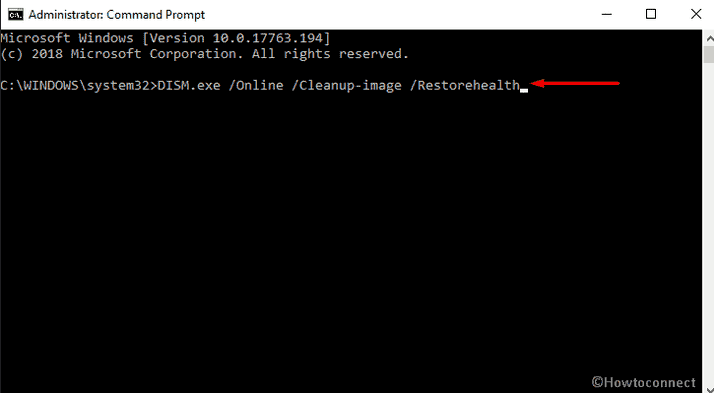
Note – Often the process gets stuck at 20%. If this happens with you too, don’t stress as it normal phenomena.
- When the DISM scan gets over, Reboot your PC to make the changes effective.
Run CHKDSK Utility
Sometimes, Bad segments in the Hard Disk causes IRQL_NOT_DISPATCH_LEVEL BSOD error in Windows 10 error. We are to identify these segments and Microsoft has a new tool for this purpose also. Built-in CHKSDK utility will significantly detect the detrimental segments also rectify accordingly. Proceed with the following guidelines –
- Press Win+S keys together from the keyboard and call up Taskbar Search on screen.
- Type CMD in the Search box and when Command Prompt appears in the result make a right click on it.
- Choose Run as Administrator from there to launch Elevated Command prompt.
- Once UAC prompts for permission, agree with its consent by tapping Yes.
- In the Black Window appearing, insert the following command matching with the shown format- chkdsk [Drive:] [parameters]
- With the command chkdsk, System will only show the disk status but will not fix any issues present. Therefore, we need to specify the command in the following way- /f /r /x.
Here,
“f” will force the utility to fix up found issues from the volume.
Letter “r” will detect the poor sectors in the Hard Disk.
Notation “x” will make the whole volume to dismount before initiating the process. Hence, finally, the command will look like- chkdsk C: /f /r /x
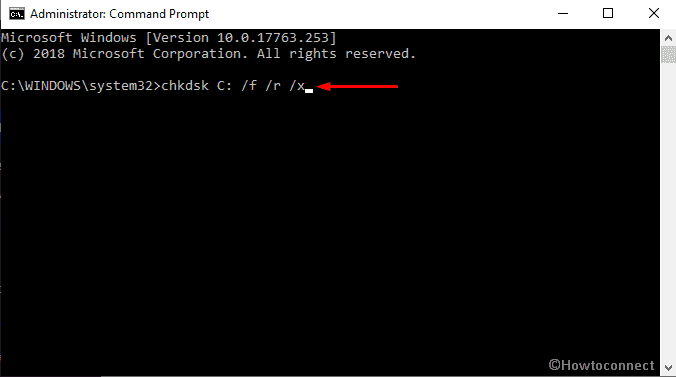
Note – C: is the drive letter where the OS is installed. If you have used other drivers to do the same task, replace the letter with D:, E: and so on.
Cleaning Junk from the system using Disk Cleanup utility
As the work progresses each day, Operating System produces huge unnecessary items, files, caches in it and stores them in Hard Disk Drives. Once gets in bigger volume, Lump of these files occupies huge space and Drive runs in a shortage of free space. Eventually, the computer will be slower and also cause IRQL_NOT_DISPATCH_LEVEL BSOD errors. Therefore, the cleaning of these junks is a dire need to maintain a healthy working system. Disk Cleanup utility is designed for freeing up space in Hard Drive. The tool will search and analyze each and every component and remove the unnecessary ones.
- Open the Run dialog by pressing Win+R hotkeys.
- When it opens, type cleanmgr in the text field and make a click on OK button.
- When the tiny dialog box comes in, do a click on the Drop down menu and select Drive letter C: followed by pressing the Enter key.
- Disk Cleanup utility will start shortly analyzing the amount of space it can recover from the volume.
- Proceeding forward, select the Clean up system files from the bottom of the appearing wizard.
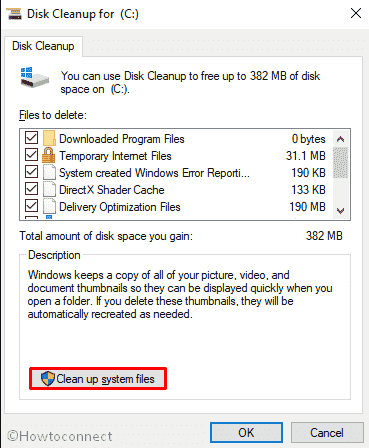
- Select the same drive letter and allow the Disk Cleanup for (C:) to be visible and start working as well.
- Before proceeding this method, ensure you have restored all the important items from Recycle Bin if present.
- Check all the options and leave Downloads and lastly, hit the OK button.
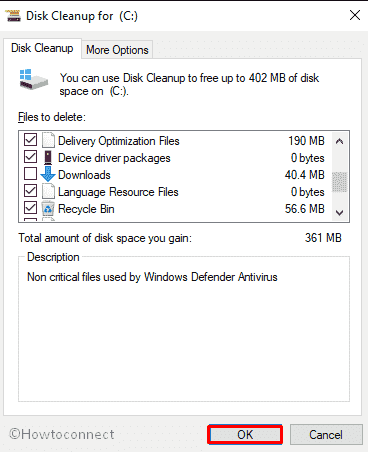
See also – How to Schedule Disk Cleanup in Windows 10
Install all possible Windows Updates
Microsoft technicians are dedicated and they are offering utmost sincerity to offer maximum benefits to the users every time. As a part of this, Updates are available after every definite period of time and they always have bug fixes inside. Outdated Windows Operating System is more likely to cause IRQL_NOT_DISPATCH_LEVEL BSOD error in Windows 10.therefore, Download the available updates using the below guidelines-
- Open the Windows Settings app using a coupled press of Win+I hotkeys from the keyboard.
- Once loaded the app, proceed to the Update & Security tile and perform a click on it to open additional setting options.
- Proceeding forward to the following page, select Windows update option from the left pane and jump to alongside right.
- You might see ‘You’re up to date” dialog here with the last checked date mentioned. However, hit Check for updates option and the system will look for available updates for your windows.
- After finishing the searching process, you will see the updates on the screen. Choose Download option under updates are ready to download.

Resolve the issues associated with RAM
An incorrect memory device, defective sectors in Random Access Memory (RAM), Wrong allocation of memory will call up IRQL_NOT_DISPATCH_LEVEL BSOD in Windows 10. Therefore, a perfect solution is mandatory to rectify these issues. However, since scanning the stick is a bit complex, Memory Diagnostic tool. In this way, your problematic sectors will be identified and you can resolve later. move through the following steps –
- Make sure that you have saved and closed all the in-progress apps on the device before proceeding.
- Move the Cursor to the Taskbar Search and make a click on it to edit.
- In the null search field, type Windows Memory and select Windows Memory Diagnostic once the results appear.
- Proceeding forward, choose Restart now and check for problems (recommended) from the rolled in Pop up menu.
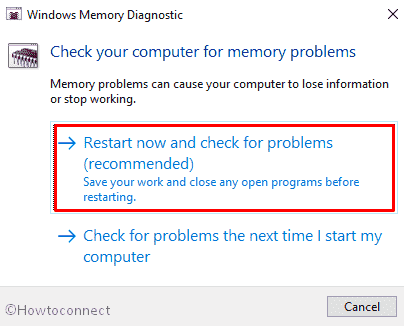
- When the system starts, a blue screen window will be visible on screen and it will detect the memory issues. After the process reaches 100%, Windows will restart automatically.
- Once the device starts again, you can see the results in the notification area of the taskbar.
- Or simply navigate to following path if you find the above process nonfunctional- Right-click Start Menu => Event Viewer => Windows Log => System.
Use Previous System Restore Point
This workaround is optional for the uses since it needs a having a previously created Restore Point. Therefore, you can obviously skip this one and follow to next resolution. Upon application to this workaround, the Operating system will roll back to a point of no error. Here is the detail of the method –
- make a combined press of Win+R keys and invoke Run dialog in Display.
- In the empty text field, type rstrui and hit the Enter key.
- This act will call in System Restore wizard on screen. In the same window, hit the Next option allowing the device to generate your PC’s Restore points.
- If you want to see more of the restore points, do a click on the boxes Show more restore points option.
- Proceeding forward, choose the last Restore Point you have created on the machine followed by clicking the Next option to move forward.
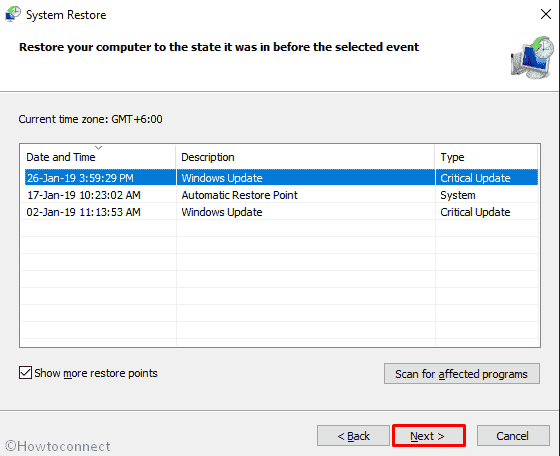
- From the following window, hit the Finish button to initiate the full process.
Read – How to Schedule System Restore Point to Create at Startup in Windows 10
Perform a clean install
It will be really pathetic at the same time frustrating if you could not fix error IRQL_NOT_DISPATCH_LEVEL using any of the above workarounds. However, we believe that no problems come without a solution. Yet we have one more resolution to apply for fixing error code 0x00000008. this is a complete installation of Windows 10. The final remedy if done with utmost perfection will potentially remove all the bugs, and eventually, there will be no chance of any error or issue further.
it is wiser to save all the necessary files and data in a safe place as Backup. Since this is a professional Workaround, you might seek help from skilled people to accomplish.
Here is How to Clean Install Windows 10 October 2018 Update.
That’s all!!!!